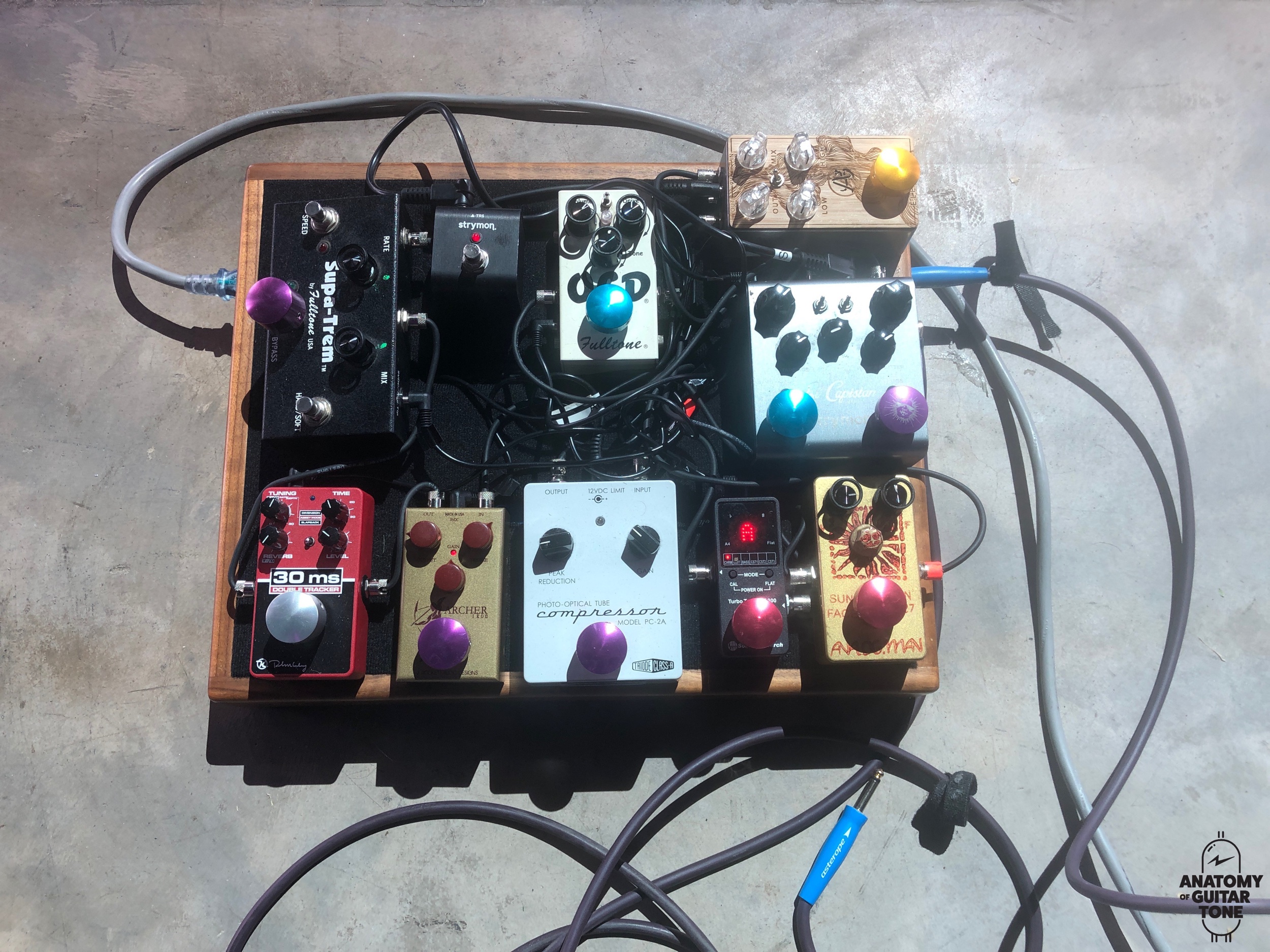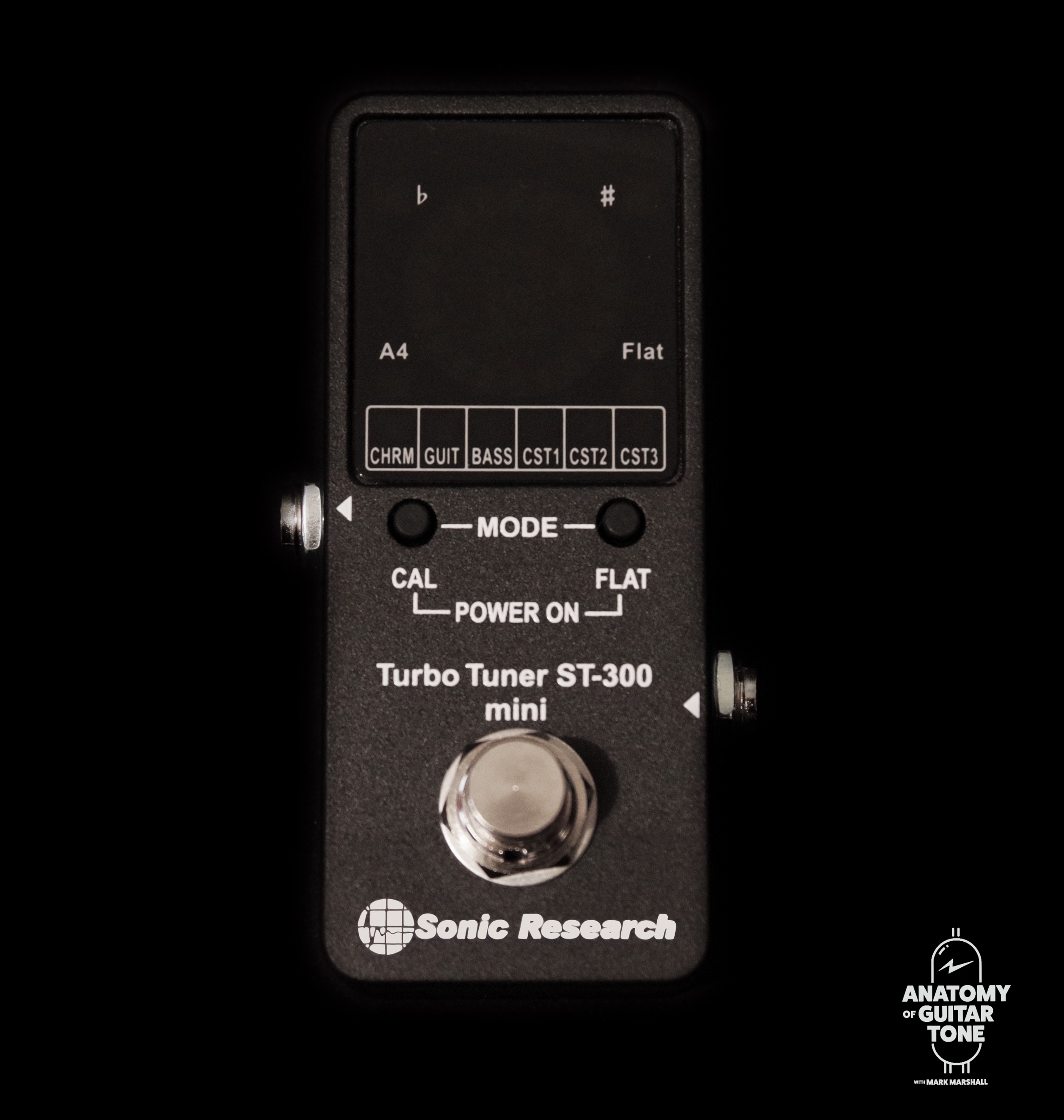Sonic Research ST-300 Turbo Tuner
Guitar tuners are a wildly underappreciated tool. You rarely see people talk about them when they’re showing off their pedalboards. They get passed over by their flashy counterparts: overdrive, fuzz, and delay.
I’d argue that a tuner is the MVP of any guitarist’s rig. It doesn’t matter how many original Klons you have on your board. If you’re playing out of tune it’s going to lead to a sour experience for the guitarist and the audience.
Although there are quite a few tuners on the market these days, they’re not all equal. I’ve tried many tuners in my career and thought I would take some time to run down my thoughts on the subject.
Needy
My tuner needs tend to be pretty demanding. I play a fair amount of festivals. They’re a bit of a chaotic scene. Things move fast. Rarely a sound check. No getting used to the environment. It’s set up and go! If I have to fiddle with a tuner to get my tuning locked, it’s going to add stress to my experience.
I want to be able to hit a note, have it instantly recognized, and be able to discern how out of tune I am. That seems a simple enough wish. But the tuner genie doesn’t always grant this wish.
Can’t You See
Another necessity for me in a tuner is bright visibility. I have poor eyesight. I was born legally blind. This doesn’t mean I can’t see. It means my vision is severely impaired. Although I have in recent years been able to improve my vision with the help of a caring eye doctor who actually doubled my vision, seeing things is still a challenge.
This especially comes into play on a bright outdoor festival stage. On an indoor stage, most tuners are quite visible. But step outside and all of a sudden you can’t see the tuner lights. In a panic, I have even built a gaffer tape roof over the tuner so I could see it, with middling success.
Many tuners don’t have an adjustment to increase the brightness, either. Sometimes I also have a headstock tuner and a tuner on top of my amp as backup. But these can be hard to see as well.
Plying the Targhee Festival in Wyoming
The Sonic Research ST-300 tuner is very bright—I almost never have a problem seeing it. The only exception is when I’m playing a festival like Targhee Fest in Wyoming. At 6,440-plus feet above sea level, the sun is extremely bright and strong. Most tuners can’t compete.
But even there, at the Targhee Fest, I was able to block the light and see the ST-300 much more easily than my other tuners. It’s just overall more visible.
On a bright outdoor festival stage the ST-300 is still visible.
Another bright festival stage where the ST-300 is clear.
The Holy Grail of Guitar Tuners
A friend and really talented guitarist, Teddy Kumpel, recommended the Sonic Research ST-300 tuner. At that point I’d tried tuners from D’Addario, Korg, TC Electronics, Peterson, Boss. You name, it I’d tried it. Except the Sonic Research.
Figures the last one I try is the secret weapon.
“The Sonic Research ST-300 tuner is a true strobe tuner. This means it’s extremely accurate—within 0.02 cents.”
The Sonic Research ST-300 tuner is a true strobe tuner. This means it’s extremely accurate—within 0.02 cents. That’s incredibly accurate. The TC Electronics PolyTune comes within 0.5 cents. That’s over a 10-cent difference!
A cent is a logarithmic unit of measure used for music intervals. It’s basically our way to mathematically measure the distance between intervals.
How sensitive to cents is the human ear? That varies by individual. I can hear the difference when I tune with the ST-300 versus a TC Electronic Poly Tune. This difference is especially apparent when playing with an in-tune piano or overdubbing guitar parts in a session. And it’s hugely apparent when setting a guitar’s intonation.
Mistaken Identity
I’ve used many tuners that at times won’t read a string. I may be trying to tune the low E string and the tuner says it’s a G. Other tuners may be pretty good at dealing with standard tuning but are a little sketchy with alternate tunings .
I like open tunings. I use a variety of them. If the tuner I’m using is having a hard time recognizing that I’m tuning my low E string down to C, it’s going to be a problem. It’s like the tuner is asking “are you sure?” Yes I’m sure! Just make sure it’s in tune!
Intonate
I’ve seen guitarists set their intonation using digital tuners such as the Korg. The problem is that digital tuners really aren’t that accurate. They can get you though a gig. But if you set your intonation with them, you will notice things getting funky as you move up the neck. I’m not talking funky like The Meters, either!
For setting intonation you need a really accurate tuner. Not a tuner that comes within 0.5 cents, which is the range of most tuners. That’s not close enough—and you will especially notice this on recordings! Take note, studio rats! The Sonic Research ST-300 comes within 0.02 cents!
Headstock Tuners
Convenient but not accurate headstock tuner.
Why not just use a headstock tuner? Sure, they’re convenient. I keep one or two in my road case for dressing room playing, for playing onstage, or for playing on the radio with no DI for acoustic instruments.
But when it comes to recording serious takes in the studio, I want something more accurate. Some headstock tuners like the Snark don’t even disclose their accuracy on their websites. They’re simply a tool of convenience.
I have a few Snark tuners. They’re cheap. I tend to lose one every month. They’re not that expensive or hard to replace, which is a real plus. But don’t be unrealistic about their accuracy.
TC Electronics and Peterson make more professional, accurate headstock tuners. Although they’re still not as fast or as accurate as the ST-300, they’re good for tuning without the benefit of a pickup.
But similar issues also plague these better headstock tuners. They’re not that fast or accurate, and they can he hard to see in bright lighting.
And I’ve experienced Confused Tuner Syndrome with them—where I’m tuning and the tuner is a little stumped about a pitch.
Mini Coup
I use the Sonic Research ST-300 Mini. It pretty much has all the features of the full-size version but takes up less pedalboard real estate. It’s actually quite compact—smaller than other mini tuners.
What many would classify as loud amps. Tale of Two Nations Tour with Nation Beat.
Some digital tuners I’ve used emit a digital sound in bypass mode. This can be a problem when I’m playing through a loud amp. It’s annoying to hear this in between songs, when I’m tuning. This happens especially with the TC Electronics PolyTune.
The ST-300, on the other hand, is fully analog—no noise.
Tracking
The ST-300 works as soon as you play a note. It never gets confused about a note, unlike the D’Addario tuner. There are moments with digital tuners where it’s a case of mistaken identity. Is it a D note or G#? Sometimes the tuner doesn’t know. This is a problem on stage.
“There isn’t a more accurate pedal tuner on the market than the ST-300. ”
The D’Addario does have a nice big screen, which I like. And although I don’t love the way it displays sharps, its biggest drawback is its speed. It’s pretty affordable but it’s slow. Slower than the TC Electronics Poly Tune. Both of these tuners are digital.
The ST-300’s screen is smaller but clearer, and I like the way sharps are displayed. So smaller actually can be clearer.
Peterson makes a digital strobe tuner, but it’s digital. This means it will have some of the same issues as other digital tuners—the most important of which are it’s not as accurate or as fast.
I’m not a fan of the Peterson. It’s rather large. The screen’s bigger, but it’s still an LCD screen, which I find harder to be see on outdoor stages. It does offer different color variations on the screen, which helps visibility in certain situations. But it’s not nearly as visible as the ST-300 LED.
Think Tank
Here’s an idea: How about displaying natural notes in one color and sharps and flats in a second color? Would be a little more clear if you’ve tuned to a D# and don’t see the # sign. That’s definitely happened to me.
Bright festival stage where it was hard to see the Korg tuner.
As I’ve mentioned, the Peterson StroboStomp is digital. This means it’s not as fast as the ST-300. The Peterson comes within 0.1 cents, whereas the Sonic Research ST-300 comes with 0.02 cents. So the Peterson still isn’t as accurate as the ST-300.
There isn’t a more accurate pedal tuner on the market than the ST-300. Second-closest is the Peterson. But it’s still almost 10 cents off!
Temperaments
There are different strokes for different folks. Let’s say you wanted to get really tweaky and set a preset for playing in the key of E versus the key of G. Many guitarists have to slightly tweak their unwound G strings for certain keys/chords to sound in tune.
“Equal tempered tuning uses a consistent interval for every scale. It sacrifices absolute precision for overall correctness.”
We use equal tempered tuning for Western instruments. Very simply, precise intervals between notes actually vary from scale to scale—a problem especially for keyboard instruments. Equal tempered tuning uses a consistent interval for every scale. It sacrifices absolute precision for overall correctness, if that makes sense. Because it’s a compromise, equal tempered tuning results in some intervals (or chords) sounding just slightly out of tune.
For example, the interval between G and B may sound more in tune than the interval between E and G#. This also tends to get exposed a little more with a unwound G string. Some guitarists aim for a middle ground when tuning, especially when a song includes two sets of intervals that aren’t locked.
You can read a little more about this phenomenon here.
You could solve this with a preset. It could save you time guessing onstage or in a session if you’re working with a song that has a grey area in its tuning. You could also save a few presets for other tunings.
James Taylor
James Taylor’s system for tuning acoustic guitars is to tweak each string to make the guitar sound in tune over as many chords as possible. It’s his way of finding a solution to the imperfections of equal tempered tuning. Let’s look at his tuning preference. Give it shot on an acoustic guitar and see if you like it.
E -3 cents
B -6 cents
G -4 cents
D -8 cents
A -10 cents
E -12 cents
All-Around Winner
I have a couple of pedalboards for different gigs. One thing that’s consistent on all of them is the Sonic Research ST-300. I really don’t like to do a gig without it.


















